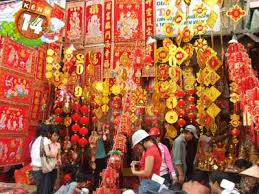Tet Nguyen Dan, or most commonly called Tet, is the most esteemed and anticipated celebration in Vietnam. Also known as the Vietnamese New Year, this is the time when Vietnamese people show their utmost remembrance and respect to their ancestors. It also serves as a grand homecoming and reunion for families to both relax and have fun. And as in all festivals, there is an abundance of traditional food which is meant to be shared to give more meaning and depth to the occasion.
Tet is held on the first day of the first month of the Lunar calendar, usually in late January. In the Gregorian calendar, it often falls on the beginning of February. The actual holiday will last one day before and about three to five days after. The festivities normally take seven days, but there are rare circumstances in which it could last up to nine days. Tet is also usually observed during the agricultural year, between harvest time and sowing of new crops, therefore a long enough time for families to take a break from working hard the whole year and spend quality time together. This year, Tet will be celebrated on February 19, 2015.
Certain customs are practiced during Tet. This includes cleaning the house several days before the big event in the belief that will drive away the bad luck of the past year. Traditional decorations consist of the Kumquat Tree, branches of peach blossoms and apricot flowers. An ancestral altar is prepared with five kinds of fruits and votive papers. The children are bought new clothes and shoes to be worn on the first day of Tet. They are also given money placed in a small red envelope for good luck and prosperity. All debts are cleared and arguments resolved to welcome the New Year with a clean slate. In general, Vietnamese people show their best traits and disposition believing that what their mood or behaviour is on Tet will carry through the rest of the year. Red and yellow are the predominant colors during this time, considered to bring good fortune.
Tet follows a general composed of the following:
- Ong Cong, Ong Tao Day (Kitchen God Day)
- Banh Chung Cake wrapping
- Family reunion and Tat Nien
- Giao Thua (New Year’s Eve) and Xong Dat (First visit to a family in the New Year) – including prayer sessions to the gods and ancestors
- First three days of the New Year – Visit paternal side on the first day, visit maternal side on the second day, visit teachers on the third day
- Visit relatives, friends and neighbours
- Hoa Vang – Burning of offerings for the ancestors practiced near the end of Tet
- Reopen business – Usually scheduled on the date which matches the owner’s age
- Tet Nguyen Tieu – First full moon of the year observed by praying in the pagodas and eating vegan food and drinking water for a peaceful mind and good luck.
Traditional Tet food is composed of many dishes, the most important of which is Banh Chung. Also called Banh Tet, it is a customary Vietnamese sticky rice cake made from glutinous rice, mung beans, pork and other ingredients. It is wrapped in giang strings and two La Dong leaves and shaped into a square. Pickled onions, boiled chicken, Mung bean pudding, Gio Cha or Vietnamese sausage, Xoi Gac or Red Sticky Rice, and roasted nuts and seeds are the other food fixtures during Tet.

Considered to be the combination of Western holidays like Christmas, New Year, Thanksgiving, Halloween and even birthdays, Tet is the ultimate definition of Vietnamese culture which tourists from all over the world come to and experience for themselves in order to truly appreciate the beauty of Vietnam.